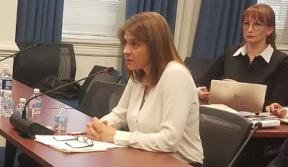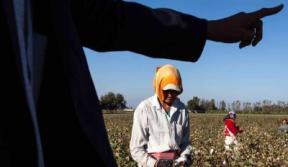Most groups talked about the need for community
organizations so that local communities can support the local schools and
ensure their children go to school. We visited newly built and refurbished
schools in two communities, both of which reported still needing more space for
all the children who want to go to school.
In one community we saw several brand new and refurbished
classrooms. The community was very proud
of the school as they showed us the classroom which accommodates 104 first
graders – in one room! The picture here
is of another village, near the town of Tiassalé, where the villagers asked us
to help them raise funds to complete a fourth classroom on their school; as the
picture shows there are many more school-age children than space in the
school.
It was inspiring to see how communities are benefiting from
social programs – schools are being built, micro-projects are being
implemented, and boreholes have been drilled for wells. But in the end, we
still came back to our core question – have these programs fundamentally
changed the nature of the cocoa sector to empower farmers to a better
negotiating position?
As we traveled from village to village, it became
increasingly clear that the programs and projects developed by companies, NGOs,
and the government have been very fragmented and uncoordinated so far. Many of the groups that were guilty of this
fragmentation agreed that it was a problem, but expressed hopes that the First
Lady’s Initiative would help to solve this problem. The National Plan of Action against Child
Labor and the National Oversight Committee chaired by Madame Ouattara is
certainly inspiring many, but financing is still needed for its implementation
and the infrastructure to ensure programs are implemented throughout the country
will take some time. If fragmentation
persists, however, Cote d’Ivoire risks ending up with dozens of pilot projects
that never culminate in a national solution to the child labor problem.
Part of the plan that companies have set forth in reaching
systematic change in the cocoa sector is certification. With the rapid growth
of programs driving certifications in the field, we are concerned about the
risk of programs scaling up too quickly without ensuring fundamental principles
are in place so that farmers’ interests are best served. As the pressure to certify
farmers grows, will these initiatives put in the necessary time and resources
to empower farmers?
Finally, as much as there is new hope for the children of
Cote D’Ivoire, it was clear that more must be done for the victims of child
trafficking in the cocoa sector. There
are some (but clearly not enough) efforts to return trafficked children to
their families or to local immigrant communities around Cote D’Ivoire, but it’s
clear that there are not enough resources for the immigrant communities to
receive the children or for the local police to support the remediation of the
children they find being trafficked.
Reports on the effectiveness of these programs were mixed at best, but
everyone agreed these efforts are under-financed.
We look forward to returning again and to working with the
many committed individuals we in order to dig deeper for answers to these and
other questions. The Ivoirians impressed
us with their energy, their openness and with how sincere and helpful everyone
was – in the projects as well as the people we met on the road. We hope you’ll stay tuned as we continue to
advocate for children’s rights and better livelihoods for farmers in the cocoa
industry.
Judy Gearhart and Adeline Lambert, with the International Labor Rights Forum, traveled to Cote d’Ivoire in December of 2012.

